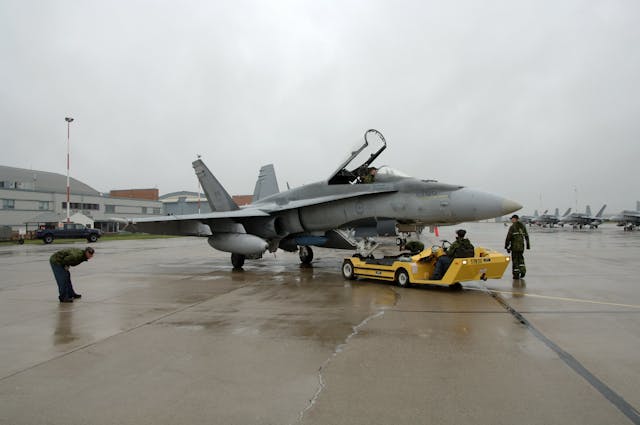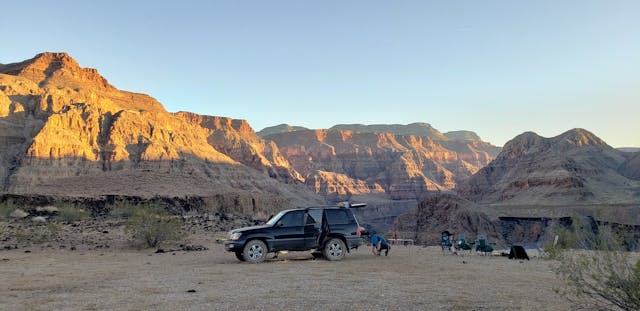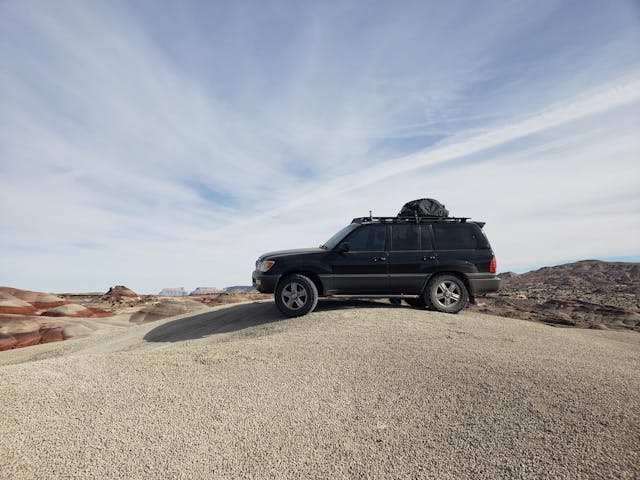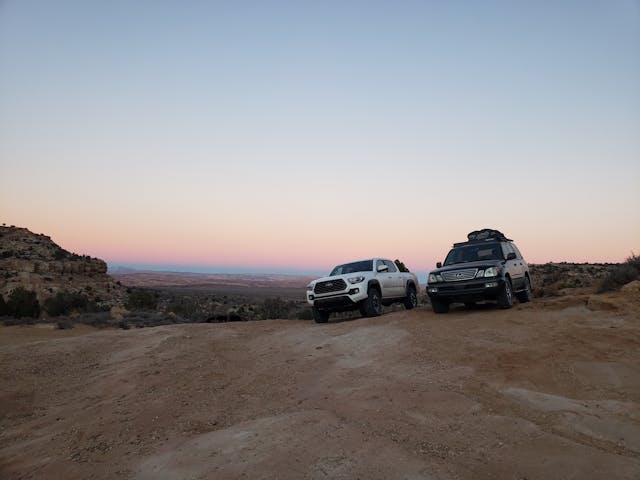Our fighter pilot’s Lexus suffers the “the taxi of shame”
This piece is part of a series from “Josh Arakes,” a senior U.S. military fighter-jet pilot who has obtained permission to share some of his life and experiences with us here at Hagerty. If you want to hear more about the Top Gun lifestyle, both as it relates to jets and cars, please let us know in the comments or by emailing tips@hagerty.com. Josh is willing to tell us anything that doesn’t compromise operational security. Enjoy! —Ed.
Thankfully, most aircraft emergencies are resolved with minor inconvenience: think returning and landing earlier than scheduled. When something goes wrong with an aircraft, there’s additional work involved for maintenance personnel and we pilots do our best to help with the troubleshooting. Such troubleshooting could involve simply describing what happened, indications (e.g. warning lights), flight conditions, et cetera. It could also mean remaining in the aircraft with the engine(s) running while specialists ask questions and work to diagnose the issue.
In some situations it requires a tow back to the parking area after landing—aka the “taxi ride of shame.” I’ve had no shortage of those in my career.
Serious emergencies might dictate shutting down the aircraft on the runway and emergency ground egressing from the aircraft (a fancy phrase for “unstrapping and climbing out, fearing your life is in danger, because it is”) and getting out of the way so responding fire crews can do their job. (Us pilots, mostly in jest, talk of not getting run over by fire trucks as we run away, bravely, from the aircraft.)
You see, while an aircraft is under tow it must have in the cockpit either a) a qualified pilot or b) a qualified maintenance person. In these circumstances, it generally makes a lot more sense for the pilot to remain in the seat; they are already in the aircraft and need to return to the parking area anyway.
For all of our Hollywood-stereotyped-fighter-pilot coolness, it’s difficult to feel cool behind a tug pulling you at 5 mph because something in your multimillion dollar aircraft no workie. A subject of endless debate among pilots: helmet on or off, in this scenario? I’m a helmet-off kind of guy, unless it’s cold out.

The first time I emergency ground egressed from an airplane was during pilot training. I didn’t actually need to do it. I was on a solo flight, with no Instructor Pilot (IP) on board, and I was in the airspace practicing aerobatics when I noticed the engine temp fluctuate just outside of limits. I (wisely) decided to return early and land. Being afraid of something really being wrong with the engine, albeit unnecessarily, I planned to shut down the aircraft on the runway and hop out. When that kind of move is warranted it should absolutely be done, but shutting down the runway at a busy pilot training base has definite impacts. (Declaring an emergency means getting priority for landing, fire trucks get rolled, and subsequent paperwork to describe what happened.) In this instance, once I described my indications to the IP over the radio, he told me to taxi clear.
I came to a stop on a taxiway near the fire trucks and proceeded to shut down the engines, unstrap, and hop out while the firefighters incredulously watched me. After the taxi of shame, I talked through the scenario and the reasoning behind my decisions with my leadership and they, ahem, helped me understand why my shutting down and egressing had been unnecessary given the relatively benign nature of my emergency.
Thankfully, I didn’t have the same experience as a buddy of mine. No kidding, he had to use his helmet as a chock to stop his recently-vacated aircraft from rolling, pilotless, across the tarmac. I would like to have been a fly on the wall listening to that most-assuredly one-way conversation that took place between him and our commander after that flight.
The goal as a pilot is to fill up your clue bag before your luck bag is emptied. What I mean by that: As one gains experience, it becomes easier to make an accurate assessment of what situation requires an emergency return, as well as what steps are needed after landing (egress, shut down, or merely taxi back once cleared by the fire chief). There can be a lot of debate concerning when it’s necessary to declare an emergency versus resorting to a simple early return; my default position was to reference the checklist (containing step-by-step details on how to handle specific issues) before declaring an emergency. Some agreed with my position, while others didn’t.
Keep in mind that issues are, by and large, quite uncommon. When one does appear, they aren’t usually serious and do not generally require fire truck support. Few are absolute emergencies, but for those that are I’m grateful the fire trucks are there to verify I’m not on fire. Suffice to say that emergencies are always declared in the obvious cases, and not necessarily in other cases.
To make a car analogy, my Lexus LX470 has a TPMS light that generally won’t go out or reset, though it occasionally will go out on its own. When it lights up again after going out, I use my experience with the vehicle to know that it’s not an emergency issue. On the other hand, a sudden, loud knocking sound emanating from the LX’s engine compartment would convince me to immediately pull over and shut off the engine …
… which is what happened as my family and I returned from a Thanksgiving week spent off-roading and camping through multiple national parks. We covered about 1450 miles in total; some 1372 miles were under our own power and the other 78 were with the LX470 on a tow truck.

As far as I can remember, it was only the second time in my entire life that I’ve had a vehicle towed home on a tow truck. Don’t get me wrong, I’ve towed a car with tow straps or used a tow-bar to drag my wheezing 1969 Jeepster Commando home plenty of times, but a tow truck and taxi ride of shame in the tow truck? Only twice.
The first was in our beloved 2006 Honda Odyssey, as described here. I don’t hold the van responsible for its need to be towed, as the splash guard under the engine compartment had been, um, forcibly removed by me after getting hung up on one of those supposedly-short concrete parking barriers. (This particular one had a piece of rebar sticking up that impaled itself on said splash guard. Ugly.) I still had the splash guard in my garage to reinstall, I just hadn’t yet done so. If the guard had been in place, the radiator would not have been run through by a rock. Thus, my fault and not the van’s.
The process that led to my second taxi ride of shame? It immediately felt more ominous than the first.
The original plan for the trip had been to take six people, all of our gear, food, water, and firewood for six days in the Lexus. That might have worked had we gone in the spring or fall when the temps were nice, but the freezing temps meant heavy, bulky winter clothes and gear, as well as an extensive quantity of firewood. As we started organizing gear, I realized there was zero chance everyone and everything would fit in or on the Lexus. We reserved a 4Runner from a local rental car company, but it had been smoked in so the rental company swapped it for a 2022 Toyota Tacoma with just over 1500 miles on it.

The trip was truly epic. The scenery alone was incredible, but combined with the family aspect, good food, and peals of laughter around the campfire, it was a phenomenal way to spend Thanksgiving. While a good chunk of the 1450 miles of the trip were on freeways/highways to get to/from the parks, the bulk of our time was spent on dirt trails in near total isolation from the outside world.
Prior to purchasing the LX470 in August of 2021, we had done a lot of camping and hiking, but a great deal of locations were inaccessible to us because we didn’t have a vehicle capable of driving off-road. The places we’ve been able to get to these past ~18 months, and the trips we already have planned for 2023, only serve to solidify in my family’s minds how much we love the Lexus and how little (read: not at all) we regret buying it.
And so it was that we found ourselves finally clearing traffic and just over an hour away from home, ready for showers and to sleep in our own beds. I was in the Tacoma and my wife and two kids in the Lexus behind me (two of our college-age kids drove three hours from the other direction to meet us at the national park, before heading to their apartments after we left the trail). I was listening to the audiobook version of Endurance, the story of Ernest Shackleton’s Arctic expedition during which their ship was crushed in the ice of the Weddell Sea and they spent nearly 500 days without standing on solid ground. My reverie was interrupted by my wife’s voice, filled with urgency, telling me that the Lexus’ engine had just started making a really bad sound.
Amazingly, we were right at a freeway exit. We pulled off the road and I hopped out of the Tacoma. My ears were met with a harsh, yet rhythmic cacophony emanating from the LX470’s 4.7-liter VVTI V-8 engine.

I’ve shut an engine down in flight, which required forcibly setting aside my disquiet about the relative silence in the cockpit that ensued as she spooled down. While I’ve, thankfully, not had to shut down my engine in a single-engine fighter, I have pulled said single engine to idle and flown a precautionary engine-out approach because I was afraid it was going to shell itself. As recounted here, I’ve driven a 1992 Nissan Pathfinder with a V-6 to a mechanic while missing a spark plug I just could not get to thread properly; that was not a happy engine noise, either.
All told, I’m not much more than a shade tree mechanic, but I’m also not new to engine issues. I distilled all that experience into one sentence, uttered to my wife, as she shut off the Lexus engine: “That’s not good.”
We found a safe spot to park the Lexus and went to grab some dinner to think through our options. My first thought was the noise was related to the timing belt service we’d had performed not quite 3000 miles earlier. According to the map, we only had another ten miles or so on the freeway before we could take a quiet surface road the remaining 65-ish miles home. Knowing that getting stuck was a real risk on our adventure, I’d packed shackles (soft and metal varieties) and tow ropes, among other rescue gear, so using the Tacoma to tow the Lexus home was a real option, as well. My wife didn’t like the idea, but if push came to shove, I felt confident I could get it done.

We shifted camping gear from the Tacoma to the Lexus to make room for my wife and kids. Then, they headed home in the Tacoma while I waited for the AAA-sourced tow truck to arrive. The tow truck arrived more than four hours later (the 78-mile tow and the lateness of the evening dissuaded most tow drivers). I was glad we’d left some blankets in the Lexus, as it was cold and had started to snow.
Eventually, the truck arrived. The driver was a fellow named Drew; I’ll have to regale you some other time about our chat, conducted we drove to the Land Cruiser specialty shop in our town to deposit the crippled LX. I will say, however, that the first thing I noticed upon climbing into the tow truck was the Glock 19 he had mounted under his dash.
My saintly wife met us at the shop at 2:00 a.m. We finally got to bed around 3:00 after loading our Honda Odyssey with the remaining gear and driving home.
***
A couple days later, the diagnosis came in: rod knock. The engine was shot. The driver’s side injectors were also toast, weeping fuel onto the floor of the shop after just a couple minutes of idling. Furthermore, half the oil was gone; per my usual pre-drive inspection, I’d verified the oil level was good, fluids were topped off, and tire pressures were set before we left home, so the oil had disappeared during the trip. A second opinion concurred with the diagnosis of rod knock; I also sent a video to a couple buddies and their immediate responses were “Rod knock!” (They next asked if I was going to swap in a diesel engine.) The timing belt repair looked great, and the marks were still aligned so it hadn’t jumped.
What could have caused this kind of damage? The mechanic’s best guess was whomever sold it to us did a poor job assembling something following a spun bearing or similar level of damage before the sale. I expressed disbelief that such an engine would have held together for the 17,000 miles we’d put on it in the preceding 18 months, but he insisted it was possible even if it wasn’t particularly likely. We didn’t have the Lexus inspected before we bought it, but its condition, service record, and my inspection and test drive indicated it had lived a life of suburban mall crawling and dealer-provided service. Nothing pointed to an engine held together by duct tape and bailing wire.
Between a fully warrantied replacement motor (with about 2/3 the miles of our current engine), new injectors, various other parts, and the 25+ hours of labor, we were staring at a bill a little north of $10,000.

Over the 36 hours or so following the news of the engine’s demise, my wife and I debated various courses of action. We could remove the upgraded parts (sliders, skid plates, roof rack, etc.), sell the Lexus as-is, and either buy another 100-series Land Cruiser (and subsequently reinstall the upgraded bits) or sell the truck and pulled parts separately to get out of the Land Cruiser game entirely. There’d be a huge financial hit if we took that route, and we’d still want to buy another off-road vehicle, making the total cost even higher. And there’d be no guarantee that whatever used vehicle we bought wouldn’t have a similar issue hiding.
In the end, we opted to stick with the known quantity and swap the engine, though not with a diesel (sorry guys, it would have been at least $6000 more to do so). There is also a supercharger option to which my wife didn’t immediately object. Up until now, we haven’t driven the Lexus much around town, opting to save its miles for trips and adventures. Once the new engine is swapped in, we’ll do a bunch of in-town miles to build trust in it and verify all is working well before our next big trip over spring break in March.
As much as it stunk to wait hours for a tow truck, we were at least back in civilization now and my out-of-pocket costs getting there were zero, excluding my AAA membership; Drew told me that without it, the cost would be $185 to put the vehicle on the tow truck and $5 per mile. A taxi ride of shame from a trail in the middle of nowhere would have cost way more.
If I had to be rescued like that, you can bet I would regret not bringing my helmet!
***
Check out the Hagerty Media homepage so you don’t miss a single story, or better yet, bookmark it. To get our best stories delivered right to your inbox, subscribe to our newsletters.



Still chuckling at “run away, bravely”…!!
I’m not sure if it’s comforting or unsettling to learn that our sky-jockeys are regular human beings and not “Hollywood-stereotyped-fighter-pilots”…
Good story. I’ve never had to shut down an aircraft engine in flight nor use a helmet as a chock (as I’m not even a pilot). But I HAVE had to be rescued from an off-road breakdown from the middle of nowhere, where the cost of the rescue nearly exceeded the value of the vehicle. That taxi ride of shame wasn’t NEARLY as painful as having to explain to my wife why our vacation fund needed to be raided that year. 🙄
Oof. I’ve not had an off-road breakdown that required towing, knock on wood. That said, the clutch on my Jeepster went on on trail but I literally coasted the 15 or so miles home in neutral so it doesn’t count. Word on the street is that there’s a version of AAA that will cover off-road tow, though I’m not sure what it’s called.
Interesting story, always disappointing when an engine fails, I’ve had a couple unexpectedly go myself…just wondering how many miles were on it when it threw the rod? And I’ve always been inspired by Shackleton myself…I’ve read quite a bit about his expedition…quite the story of survival and leadership.
Good question about the engine’s total miles that I didn’t think to put in the piece, but it only has about 120,000 miles. That’s not a ton of miles for most engines, but for the legendary Toyota motors it just finished getting broken in at 120k.
This is what I was thinking. These engines are legendary for reliability…Doesn’t make sense at all.
In a 1983 Toyota 4WD shortbox pickup with 2″ lift kit and 27″ knobby tires, I thought I could go anywhere that I had the guts to try (this was circa 1985). I had had Jeeps and was a fairly experienced off-road driver – or so I thought. But the stock parts under my truck weren’t up to the terrain I was in. I had been going for several hours in a very rocky canyon in the Owyhee Mountains, and was climbing out of the boxed end to try and reach a 2-track up on the mountain. The little truck was a great climber, but really not built to be a rock-crawler. It had been rough going and I had come down hard on some boulders more than once while crawling over them. I was almost there. As I turned around the downhill side of a rocky outcropping (at about 27 degrees sidehill), the left (downhill) steering arm snapped. This threw the truck to the left, and down we rode – about 25 yards straight down. I was lucky that the talus was loose enough that I just slid nose down, and the disabled steering didn’t really give the front tires a chance to get a grip, as the slope got steeper and if I’d gone sideways I likely would have rolled. At the bottom, I crunched into a VW sized boulder and munched the radiator into the fan. I was wedged about 35 degrees tailgate up, with no steering and no motor – literally between a rock and a hard place. There was no chance to separate the truck from the rock to even begin to effect repairs, even if I’d had tools and parts, which I didn’t. So it was a choice between some sort of tow and just abandoning it. After a four-hour hike out, a call from a pay phone, and about 76 cups of coffee at a cafe, two tow trucks rolled up. We found and went up the 2-track road, and through superhuman efforts by the truck drivers and with several spools of cable and some chains, they got it out. It was getting dark and pulling that thing down the mountain was a whole ‘nuther adventure, but we left it alongside the highway and headed for town. The next day, I rented a trailer to go up there and bring it home. The charges for the two hoist-boom trucks to come from town and go up there was heart-stopping. But due to their heroism, I also included generous tips for the two guys who took me up and brought it down. The trailer charge was “petty cash” by that point. I rebuilt the truck and traded it in on an ’86 the next spring. And I never again went into that canyon, even on foot! 😃
Josh, question why on earth would you put $10,000 into a blown motor of a toy SUV, you could have got a great American SUV, a Tahoe or Suburban or Jeep Wagoneer, that will go 250,000 miles with regular maintenance, with the $$’s you got to scrap the Asian toy and the $10,000 in repair money. NFCU would even let you finance 100 percent if you wanted to keep the cash for reserve. Gee I always thought you jet jockeys were supposed to be the beast and brightest. 🙂 🙂
Tell me how you really feel.
You’re the first person I’ve heard describe a 100 Series Land Cruiser / LX470 as a toy. Our LX470 has about 120,000 miles on it and I plan to drive it 350,000+ miles; most owners will tell you that 250k miles is just getting started on these vehicles.
I’ve not had a car payment in many, many years and Suburbans, Tahoes, and Wagoneers cost a breathtaking amount of money. This jet jockey’s brain says I’d rather not spend $70k+ on a vehicle at all, let alone one I intend to off road and will sustain a variety of damage commiserate with that activity.
Thanks for reading!
Toyota should take this engine and break it down to figure out why it died. As I said above these are as legendary -reliability-wise- as any motor ever built…